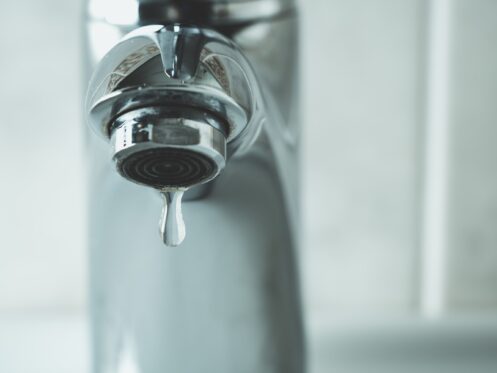Kitchen and bathroom faucets receive a lot of daily use, so it comes as no surprise that some of the internal components in a faucet will eventually wear out. The issues you’ll most commonly encounter are a faucet continuing to drip after you shut it off or water coming out of the base or body of the faucet when it’s turned on. Certain faucet issues are easy DIY fixes, but others require calling a kitchen and bathroom plumber.
In this article, we’ll look at the most common faucet issues, what can cause them, and how to fix them.
Water Leaking Out of the Faucet Base
This issue typically occurs due to a worn-out washer or rubber O-ring. These inexpensive components are inexpensive and relatively easy to replace, which is something you may be able to do yourself. However, it does require taking the faucet apart, and you could easily damage or ruin it if you’re not careful and don’t know exactly what to do.
The Faucet Keeps Dripping
Diagnosing the reason why a faucet is continually dripping can be more challenging, as the cause can vary depending on the type of faucet. You may want to call a plumber for a dripping faucet since we’ll be able to quickly and accurately diagnose the specific issue. A dripping faucet isn’t necessarily a major issue, but it can waste 1 to 6 gallons of water a day. That adds up and can cost you a lot of money over time.
For a compression faucet, a worn-out washer or valve seat typically causes dripping. You may need to replace the entire faucet if the issue is the valve seat, as this component can’t always be removed. Compression faucets have two handles, but these faucets aren’t common anymore. These days, most two-handle faucets you see are cartridge faucets, and this type of faucet can drip due to a worn-out O-ring or a bad cartridge. Replacing a cartridge is best done by a plumber, just to make sure you don’t damage the faucet or the new cartridge. The latter component is a concern, as some cartridges cost well over $100.
One-handle faucets are either a ball faucet or a ceramic-disc faucet, and you can easily tell the difference between the two by the handle. On a ball faucet, the handle is located on top and moves from side to side to adjust the water temperature. Ceramic-disc faucets typically feature a handle on the side, and to turn the water on, you need to pull the handle away from the spout.
If you have a ball faucet that’s dripping, it is usually a sign of a worn-out gasket or spring. A ceramic-disc faucet that’s dripping is always a sign that one of the discs is worn out or broken. Ceramic-disc faucets are the most durable and least prone to dripping, which is part of the reason why they also tend to be the most expensive.
The Faucet Handle Won’t Turn
Another issue that you may encounter is that the handle on a faucet starts becoming more difficult to turn or won’t turn at all. This type of issue is most common with two-handle faucets, but it can potentially happen to any faucet. In most cases, the problem occurs due to a buildup of mineral deposits within the faucet.
If mineral deposits are the culprit, you can sometimes fix the faucet by spraying the handle with white vinegar and letting it sit to loosen up the deposits. Another thing to try is spraying the moving part of the handle with lubricant to see if it then moves smoothly and easily.
Depending on the type of faucet, you may need to remove the handle to clean it thoroughly or to lubricate it properly. Some faucets have a small screw that allows for easy removal of the handle. On others, you’ll need to hold the handle in place and use a wrench to unscrew it. If you need a wrench to remove the handle, make sure to place a cloth around the handle before putting the wrench on to avoid scratching the finish or otherwise damaging the handle. Before trying to remove the handle, shut off the water to the faucet.
Other possible issues that can cause a faucet handle to get stuck include rust and corrosion, a worn-out cartridge, or a worn-out gasket. A plumber can replace the cartridge or gasket in just a few minutes. If the internal parts of the faucet are severely corroded, you’ll need to replace the whole thing.
The Faucet Handle Is Loose or Wobbly
The screw that holds the faucet handle to the base can also become loose over time, resulting in a loose and wobbly handle. If the handle is too loose, the water may not come on when you turn the handle because it fails to open the cartridge or valve.
You’ll often see a small set screw near the base of the handle. In this case, use an Allen wrench to turn the screw and retighten the handle. If there isn’t a set screw, you’ll need to tighten the handle by putting a standard wrench on it and turning it. There’s also a chance that the part of the handle that screws onto the base is broken, in which case you’ll need to replace the faucet or at least its handle.
Water Pressure Is Low
Another common issue is when the water pressure at one kitchen or bathroom faucet is lower than the rest of the house. This issue is prevalent with kitchen faucets, typically occurring because the aerator is clogged with mineral deposits. Mineral deposits can also cause the aerator to spray water at angles instead of producing a single steady stream.
Soaking the aerator in vinegar for at least 15-20 minutes is usually sufficient to remove mineral deposits and unclog it. You can sometimes do this by tying a plastic bag filled with vinegar onto the spout. However, it may be necessary to remove the aerator and scrub it clean after you’ve soaked it in vinegar.
No Water Is Coming Out of the Faucet
There are a few things you should check first if no water comes out when you try to turn a faucet on. The first is to see if the shutoff valves on the water lines underneath the faucet are still open. The next step is to try another plumbing fixture just in case your water supply was shut off for some reason.
In some cases, the aerator can become so clogged that it prevents any water from flowing. Try cleaning the aerator as we outlined above. If you still can’t get the water to come on, it usually means you’re dealing with a broken or clogged cartridge or valve. If this is the case, the only option is to disassemble the faucet and thoroughly clean or replace this component.
For over 25 years, Horizon Services has been providing leading residential and commercial plumbing services in Englewood, CO and the Denver Metro area. No job is too big or small for our team to handle, and we’ll make sure that whatever issue you’re dealing with gets fixed properly.
To schedule an appointment for faucet repair, installation, or any other plumbing service, contact us today.


